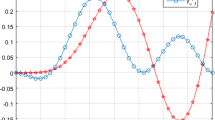Abstract
This paper focuses on the compensation of disturbances in linear dynamical systems with time-varying delays. The objective is to reduce the effect of any measured disturbances and restore the observations to their normal state by a final time T. The research paper presents a minimum energy problem describing the mathematical framework to obtain a convenient control ensuring the disturbance compensation. The presented application to the two-dimensional diffusion equation emphasizes the practical applicability and relevance of the proposed approach.
Similar content being viewed by others
Data availibility
The availibility of data and material statement is not applicable.
References
Emamirad H (2003) On the theory of remediability. Banach Center Publ 63(1):165–176
Afifi L, Chafiai A, Bel Fekih A (2002) Enlarged exact compensation in distributed systems. Int J Appl Math Comput Sci 12(4):467–477
Afifi L, El Jai A (2015) Systèmes distribués perturbés. Collection Études. Presses Universitaires de Perpignan, Perpignan
Afifi L, Lasri K, Joundi M, Amimi N (2016) Feedback controls for exact remediability in disturbed dynamical systems. IMA J Math Control Inf 35(2):411–425. https://doi.org/10.1093/imamci/dnw054
Qaraai Y, Bernoussi A, El Jai A (2008) How to compensate a spreading disturbance for a class of nonlinear systems. Appl Math Comput Sci 18:171–187. https://doi.org/10.2478/v10006-008-0016-9
Delfour MC, Manitius A (2006) Control systems with delays: areas of applications and present status of the linear theory. In: New trends in systems analysis: international symposium, versailles, December 13–17 (1976) IRIA LABORIA Institut de Recherche d’Informatique et d’Automatique Rocquencourt-France. Springer, Berlin Heidelberg
Volterra V (1928) Sur la théorie mathématique des phénomènes héréditaires. J Math Pures Appl 7:249–298
Souhaile S, Afifi L (2020) Cheap compensation in disturbed linear dynamical systems with multi-input delays. Int J Dyn Control 8:243–253. https://doi.org/10.1007/s40435-018-00505-6
Souhaile S, Afifi L (2020) Minimum energy compensation for discrete delayed systems with disturbances. Discrete Contin Dyn Syst- S. https://doi.org/10.3934/dcdss.2020119
Batakài A, Piazzera S (2005) Semigroups for delay equations. A K Peters/CRC Press, Florida
Batakài A, Piazzera S (2001) Semigroups and linear partial differential equations with delay. J Math Anal Appl 264(1):1–20
Hinrichsen D, Pritchard AJ (2005) Mathematical systems theory I: modelling. State space analysis, stability and robustness. Springer, New York
Zhong R, Yang Z (2006) Delay-dependent robust control of descriptor systems with time delay. Asian J Control 8:36–44. https://doi.org/10.3182/20080706-5-KR-1001.00822
Curtain RF, Pritchard AJ (1978) Infinite dimensional linear systems theory. Lecture notes in control and information sciences. Springer-Verlag, New York
Engel KJ, Nagel R, Brendle S (2000) One-parameter semigroups for linear evolution equations, vol 194. Springer, New York
Lions JL (1968) Contrôle optimal de systèmes gouvernés par des équations aux dérivées partielles. Dunod, Malakoff
Klamka J (1976) Controllability of linear systems with time-variable delays in control. Int J Control 24(6):869–878. https://doi.org/10.1080/00207177608932867
Liu Y, Zhao S (2012) Controllability analysis of linear time-varying systems with multiple time delays and impulsive effects. Nonlinear Anal Real World Appl 13(2):558–568. https://doi.org/10.1016/j.nonrwa.2011.07.038
Souhaile S, Afifi L (2021) Cheap controls for disturbances compensation in hyperbolic delayed systems. Int J Dyn Syst Differ Equ 10(6):511–536. https://doi.org/10.1504/IJDSDE.2020.112758
Rabah R, Michel M (1996) Structure at infinity revisited for delay systems. In: IEEE-SMC-IMACS multiconference, symposium on robotics and cybernetics (CESA’96). https://www.hal.science/hal-01466183/document
Rabah R, Malabre M (2004) Weak structure at infinity and row-by-row decoupling for linear delay systems. Kybernetika 40(2):181–195
Funding
This research received no specific grant from any funding agency in the public, commercial, or not-for-profit sectors.
Author information
Authors and Affiliations
Contributions
LA conceived the idea presented and verified the analytical methods. SS developed the theory and performed the calculations. All the authors discussed the results and contributed to the final manuscript.
Corresponding author
Ethics declarations
Conflict of interest
All authors declare that they have no conflicts of interest.
Appendix A: Minimum energy compensation using LQR approach
Appendix A: Minimum energy compensation using LQR approach
For sake of diversity, we present hereafter a general approach also widely used, where this compensation problem is examined as a Linear Quadratic Regulator minimization. In practice, the comparison of methods is classically recommended for the implementation of any analytical method. The LQR method is practically and widely used in control theory.
We consider the following cost function defined for a finite time horizon T as follows:
where Q end R are self-adjoint operators assumed to be positive and coercive. The operators H and \({\tilde{H}}\) are defined, respectively, in (13) and (14).
We examine thereafter the existence of \(u^*\in L^2(0,T;\textrm{U})\) such that:
We have:
i.e.,
where
and
also
According to Lax–Milgram theorem, J admits a unique minimum in \(u^*\) characterized by:
or equivalently
or also
i.e.,
Then
Consequently, the corresponding optimal control is given by:
Let us remark that if \(Q=I\) and \(R=\alpha I\), we obtain:
and if \(\alpha<<1\) (i.e., \(\alpha \) is small), one obtain practically the same results established using the Hilbert Uniqueness Method (22). Therefore, the two methods are sufficiently consistent.
Rights and permissions
Springer Nature or its licensor (e.g. a society or other partner) holds exclusive rights to this article under a publishing agreement with the author(s) or other rightsholder(s); author self-archiving of the accepted manuscript version of this article is solely governed by the terms of such publishing agreement and applicable law.
About this article
Cite this article
Souhaile, S., Afifi, L. Optimal energy compensation for disturbed systems with time-varying delays. Int. J. Dynam. Control 12, 1055–1062 (2024). https://doi.org/10.1007/s40435-023-01249-8
Received:
Revised:
Accepted:
Published:
Issue Date:
DOI: https://doi.org/10.1007/s40435-023-01249-8




